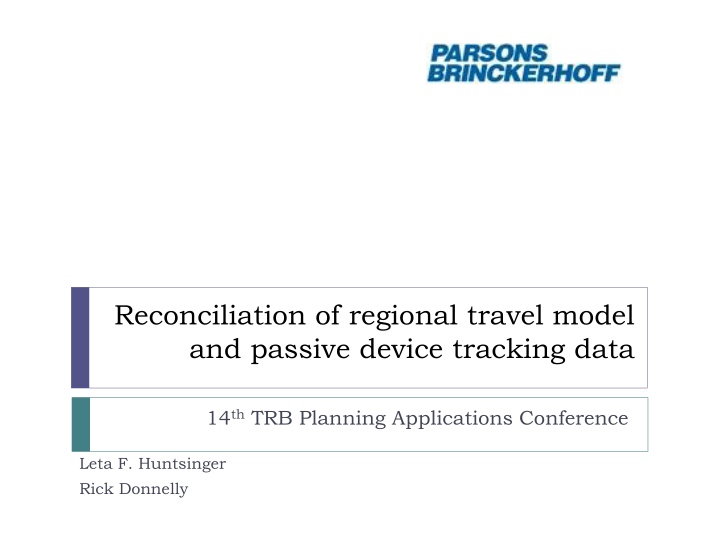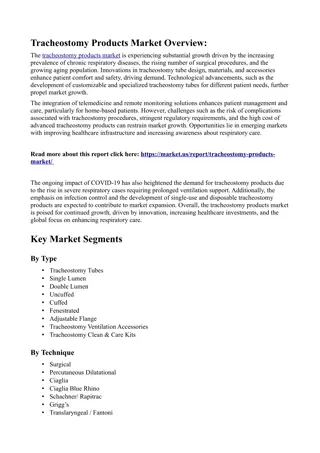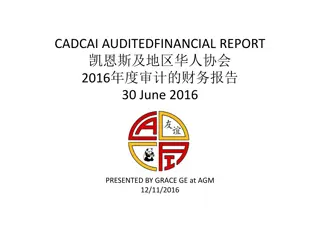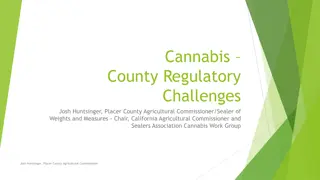
Insights on Regional Travel Data Collection and Analysis
Explore the utilization of passive mobile phone data for gathering travel information, challenges faced in data reconciliation, and comparative analysis of traditional survey data versus passive tracking data at the 14th TRB Planning Applications Conference.
Download Presentation

Please find below an Image/Link to download the presentation.
The content on the website is provided AS IS for your information and personal use only. It may not be sold, licensed, or shared on other websites without obtaining consent from the author. If you encounter any issues during the download, it is possible that the publisher has removed the file from their server.
You are allowed to download the files provided on this website for personal or commercial use, subject to the condition that they are used lawfully. All files are the property of their respective owners.
The content on the website is provided AS IS for your information and personal use only. It may not be sold, licensed, or shared on other websites without obtaining consent from the author.
E N D
Presentation Transcript
Reconciliation of regional travel model and passive device tracking data 14thTRB Planning Applications Conference Leta F. Huntsinger Rick Donnelly
Introduction Passively collected mobile phone data has shown promise as a low cost option for obtaining travel data: Speed data (Using Cell Phone Technology to Collect Travel Data, Kyle Ward) Trip tables (Origin Destination Study using Cellular Technology for Mobile, Al, Kevin Harrison) Freight Data (Freight Data Collection Technique and Algorithm using Cellular Phone and GIS Data, Ming-Heng Wang, et. al.) other Comparison of passively collected data against traditionally collected survey data 2
Challenges Household surveys behaviorally rich, but small sample size at TAZ to TAZ level Small TAZ to TAZ observations limit our understanding of flows at the sub-district level Many small MPOs cannot afford household surveys Trip distribution parameters are the most challenging to transfer Passively collected data Large sample size, but lacks behavioral richness 3
Process Convert AirSage person trips to vehicle trips AM peak hour assignment of AirSage Disagg to TAZ Apply AM factors to AirSage matrix AM peak hour assignment of TRM Apply factors to AirSage matrix Add IE, EI, and EE trips to AirSage matrix Develop AM factors from TRM data Summarize MOEs and compare 6
Results travel time comparisons Trip Length Distribution (CongTT mins) 7.00 6.00 TRM slightly higher % of shorter trips 5.00 4.00 3.00 2.00 1.00 0.00 13 17 21 25 29 33 37 41 45 49 53 57 61 65 69 73 77 81 85 89 93 97 1 5 9 101 105 109 113 117 121 TRM Percent AirSage Percent Average Trip Length (TT) TRM Air Sage 14.42 15.51 7
Results district to district flows District Map District Trip Table Color Coded by Absolute and Relative Error 1 2 3 4 5 6 7 8 9 10 11 12 1 2 3 4 5 6 7 8 9 10 11 12 8
Results Assignment MOEs Functional Classification 23 26 are rural facilities 9
Findings and Recommendations Early data set includes Sprint data only Great source of validation data Low cost option Lacks behavioral richness of household survey Larger sample than household survey Continuing improvements are needed Useful to validate an estimated trip table Add to toolbox 13
Acknowledgements Co-author Rick Donnelly Kyle Ward, CAMPO Air Sage 14



